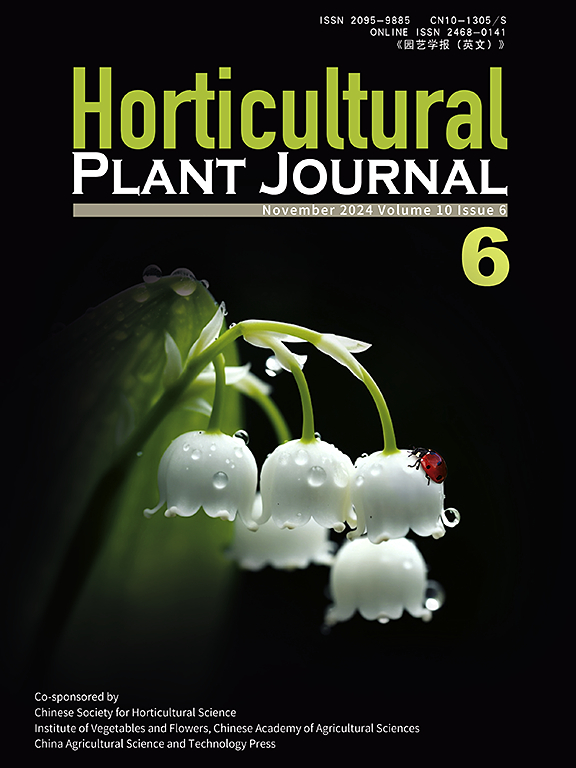在灌溉条件下,薰衣草精油含量和成分对脱落酸的响应变化
IF 6.2
1区 农林科学
Q1 HORTICULTURE
引用次数: 0
摘要
干旱作为最具灾难性的非生物胁迫,对植物的生长发育构成了重大威胁。在植物应对干旱胁迫的机制中,倍半萜类激素脱落酸(ABA)起着至关重要的作用。有一种假说认为外源外源ABA可以积极影响薰衣草精油(薰衣草精油)的萜类含量,从而增强薰衣草对干旱胁迫的抵御能力。采用随机完全区组设计试验,设3个重复和4种灌溉方案,包括I4[30% - 40%田间容量(FC)]、I3 (50% - 60% FC)、I2 (70% - 80% FC)和I1 (90% - 100% FC)作为对照。施用3种浓度的ABA,分别为A3 (30 μmol L−1 ABA)、A2 (15 μmol L−1 ABA)和A1(蒸馏水)。结果表明,除相对含水量(RWC)和茎干质量外,干旱对其他性状均有显著影响。ABA对所观察性状的影响取决于植物所暴露的干旱程度。其中,I4A2条件下黄酮类含量、总抗氧化活性、过氧化物酶(POX)活性和EO含量最高。相反,在I4A3条件下,超氧化物歧化酶(SOD)、过氧化氢酶(CAT)活性和脯氨酸水平最高,而在I3A2条件下,EO产量最高。EO分析显示,在不同干旱和ABA施用水平下,存在共同的指示性化合物,包括芳樟醇、樟脑、冰片、甲酸冰片酯和氧化石竹烯。单萜类和倍半萜类化合物的生成规律有明显的变化趋势,I2A3处理组单萜类碳氢化合物的生成浓度最高(平均为12.92%),I1A1处理组单萜类化合物的氧化浓度最高(平均为64.76%)。相反,I4A3和I4A1组的倍半萜类化合物含量最高(14.98%),含氧倍半萜类化合物含量最高(10.46%),表明单萜类和倍半萜类化合物在干旱条件下具有ABA的作用。结果表明,随着干旱程度的增加,含氧单萜化合物的浓度逐渐降低。相反,在任何给定的干旱水平下施用ABA似乎都会导致相同条件下氧化单萜化合物浓度的增加。因此,在高胁迫干旱条件下,植物在ABA的帮助下,分配了更多的萜类前体来生产具有相同性质的倍半萜类化合物。本文章由计算机程序翻译,如有差异,请以英文原文为准。
Changes in essential oil-content and composition of Lavandula angustifolia ‘Hidcote’ in response to abscisic acid under irrigation regimes
Drought, as the most catastrophic abiotic stress, poses a significant threat to the growth and development of plants. Among the mechanisms employed by plants to cope with drought-induced stress, abscisic acid (ABA) which is the sesquiterpene hormone, occupies a pivotal role. A hypothesis has emerged that the exogenous application of ABA can positively influence the terpenoid content of Lavandula angustifolia cv Hidcote essential oil (EO), thereby conferring enhanced resilience to drought stress. A randomized complete block design experiment was conducted with three replications and four irrigation regimes, including I4 [30 %–40 % of field capacity (FC)], I3 (50 %–60 % FC), I2 (70 %–80 % FC), and I1 (90 %–100 % FC) as control. Application of ABA spraying included three concentrations, A3 (30 μmol L−1 ABA), A2 (15 μmol L−1 ABA), and A1 as control (distilled water). Results revealed that drought significantly affected all studied traits except for relative water content (RWC) and shoot dry mass. The ABA impact application on the observed traits was found to be dependent upon the level of drought to which the plants were exposed. Specifically, the highest levels of flavonoid content, total antioxidant activity, peroxidase (POX) activity, and EO percentage were observed under I4A2 conditions. Conversely, the highest levels of superoxide dismutase (SOD) and catalase (CAT) activity, and proline were recorded under I4A3 conditions, while the highest EO yield was obtained under I3A2 conditions. Analysis of the EO revealed that there were common indicative compounds across the varying levels of drought and ABA application, including linalool, camphor, borneol, bornyl formate, and caryophyllene oxide. The production pattern of monoterpene and sesquiterpene compounds demonstrated a distinct trend, with the highest concentration of monoterpene hydrocarbon compounds (average of 12.92 %) being observed in the I2A3 treatment group, and the highest concentration of oxygenated monoterpene compounds (average of 64.76 %) being recorded in the I1A1 group. Conversely, the most significant levels of sesquiterpene hydrocarbon compounds (14.98 %) and oxygenated sesquiterpene compounds (10.46 %) were observed in the I4A3 and I4A1 groups, respectively, showing the efficacy of monoterpenes and sesquiterpenes from the action of ABA under drought conditions. The observed results indicated that the concentration of oxygenated monoterpene compounds decreases with an increase in drought level. Conversely, the application of ABA at any given drought level appears to resulted in increased concentrations of oxygenated monoterpene compounds in the same conditions. It may be concluded that plants under high-stress drought conditions allocate more terpene precursors to the production of sesquiterpene hydrocarbon compounds, aided by ABA with the same properties.
求助全文
通过发布文献求助,成功后即可免费获取论文全文。
去求助
来源期刊

Horticultural Plant Journal
Environmental Science-Ecology
CiteScore
9.60
自引率
14.00%
发文量
293
审稿时长
33 weeks
期刊介绍:
Horticultural Plant Journal (HPJ) is an OPEN ACCESS international journal. HPJ publishes research related to all horticultural plants, including fruits, vegetables, ornamental plants, tea plants, and medicinal plants, etc. The journal covers all aspects of horticultural crop sciences, including germplasm resources, genetics and breeding, tillage and cultivation, physiology and biochemistry, ecology, genomics, biotechnology, plant protection, postharvest processing, etc. Article types include Original research papers, Reviews, and Short communications.
 求助内容:
求助内容: 应助结果提醒方式:
应助结果提醒方式:


